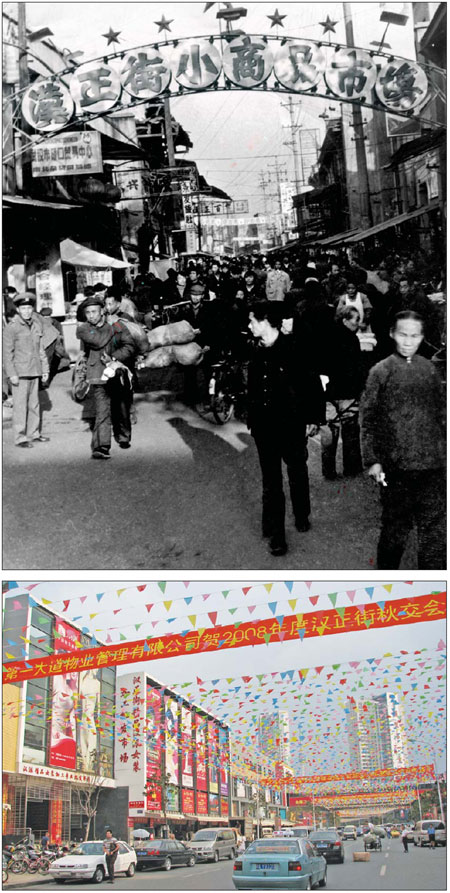Testing times for old market
By Zhou Lihua and Meng Jing ( China Daily European Weekly )
Updated: 2011-04-29
|
|||||||||
Hanzhengjie traders face uncertainty as Wuhan govt starts demolition
|
|
In a notoriously congested area in the city center of Wuhan hides a small-commodity wholesale market selling everything from kitchenware to office supplies.
The first to practice the free market concept in the 1980s, Hanzhengjie Market nurtured the first 103 private business owners in the city.
However, with more wholesale markets blossoming all over the country and having fallen victim to recent fires, the Wuhan local government has decided to demolish the area and upgrade it into a new shopping center, putting this treasure trove of knick-knacks on the verge of disappearance.
"Hanzhengjie Market was the largest collecting and distributing hub in the 1980s, selling goods to every corner in China," says Luo Jianguo, a member of the administrative committee with the market.
Suppliers and buyers flooded to Hanzhengjie to do business. Goods were sourced from all over China and sold across the country during the golden time in the 1980s, Luo says.
The situation started to change in the 1990s with similar markets emerging across China. "Suppliers didn't need to travel to Wuhan to sell their products. They could do it locally," Luo says.
With online shopping getting more popular, Hanzhengjie's situation is getting worse.
Starting from a 400-meter street market with 103 venders in 1979, Hanzhengjie has expanded to an area of 1.67 sq km with around 25,000 shops of various sizes and types, generating a turnover of 50 billion yuan (5.3 billion euros) in 2010.
Around 34,700 people live and work in each square kilometer of the market, four times those in downtown Wuhan.
Porters, motorcycles and trucks frequently shuttle from shop to shop, delivering goods from 4 am every day. But the busy business comes with terrible traffic. Taxi drivers in Wuhan usually drop their customers 400 meters away from the market to avoid the chaos.
Several fires in the past five years have taken their toll, including a blaze in January that killed 14 people, pushing the local government to decide on the reshaping of the market.
The demolition started in March, and included Gu Wangming's 2,000-sq-m home decoration store.
Gu, who came to the market in 1998, is famous in Hanzhengjie, not only because of his postdoctoral degree but also his store, which is one of the largest home decoration stores in Central China.
Originally from Jiangsu province, the former university teacher spotted the niche market of high-end home decoration in Central China and pioneered the industry by running a store named Eastern Arts.
"At the beginning, there were only four major players in home decoration in Hanzhengjie. But now, there are hundreds of shops doing the same business here," Gu says, adding that the fierce competition has reduced his profit margin.
However, what concerns him more is the demolition of the market. "I still have a 400-sq-meter shop in Hanzhengjie. But in the wholesale industry, the bigger size shop you have, the better, because you can offer wider options to your clients," he says.
There is no official plan regarding the future of the Hanzhengjie Market yet. Jiang Wenfang, head of the Hanzhengjie administrative committee, refused to reveal any details about the demolition, only emphasizing the change is unstoppable.
"Hanzhengjie has a golden location. The current use as a small-commodity wholesale market definitely underestimates its value," he says. Loudspeakers in the market repeatedly persuade shop owners to move.
However, the alternative soon-to-be market hub of Hankoubei, which is designed to be the next collection and distribution center in Wuhan, is a one-hour drive from Hanzhengjie.
"It's in a suburban area. We don't want to move there," says Liu Fei, who has been running a clothing wholesale shop since 1999.
Liu says that she has been enduring rising rent in Hanzhengjie because of its golden location. "I paid 10,000 yuan a year for a shop less than 4 sq-m in 1999, which has jumped to 60,000 yuan this year," she says.
The convenient logistics provided by Hanzhengjie, 30 minutes away from a train station, is another selling point. "People may go straight to (competing market) Yiwu if we move to a remote area with premature infrastructure," Liu adds.
The average rent in Hanzhengjie per month is around 300 yuan per sq m, while in Hankoubei it is around 20 yuan.
But most shop owners in Hanzhengjie interviewed by China Daily say that they are reluctant to move.
Gu Wangming, who made several trips to Hankoubei in 2010, says most of the shops haven't been rented, estimating it will be two to three years before that area grows into a decent wholesale market.
He worries that if Hankoubei cannot successfully lure as many shop owners as possible, the No 1 wholesale market in Central China may disappear forever with the demolition of Hanzhengjie Market.

